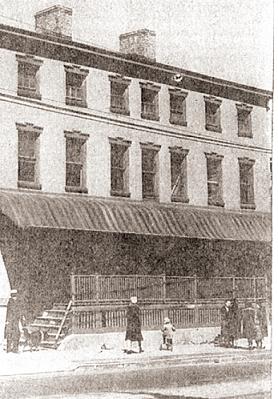The following is a compilation of articles taken from the publication called The Middle Villager. They depict Middle Village “back in the day.” – Lorraine Sciulli
How Metropolitan Avenue Began (article dated November 1995)
Metropolitan Avenue, which cuts Middle Village in half, began as an old Indian trail. The Indians going through the forest had made this path, and as time went on, and more and more settlers moved to this place, the path became wider and wider. In 1896 it became a County Road and was given the name of Metropolitan Avenue.
In the old days, around 1850 when it was still a dirt road, it had to be kept open in winter by snowplows. These were drawn by horses. This work cost money and in order to raise the money, a tollgate was built where everyone who wanted to use the road had to pay. A farmer with one horse and wagon had to pay three cents. A farmer with two horses hitched to his wagon had to pay six cents. In the old days, before the road was paved, it had a rail fence on both sides, and cherry trees and maples grew all along this road, which extended from Newtown Creek to Jamaica Avenue.
It was along this road that the farmers in the early part of the nineteenth century drove their produce to market. They drove to the ferry landing owned by James Way. It was named English Kills. The farmers drove aboard the ferry which took them by way of Newtown Creek to the River and to Catherine Market in Manhattan.
A man named Martin Suydam opened a stagecoach line over the road in 1852 between Middle Village and the Grand Street Ferry. When there was snow on the ground he had to use sleighs, but it was very hard for the horses. In winter they slipped on the snow and ice and in summer they sank into the mud, so the project had to be given up.
The Old Way Tavern
In 1845, Samuel Way, descendant of the colonial settler who came to Middle Village in 1676, built a tavern in Middle Village. It was the largest tavern on Long Island, being 3 stories high and constructed of spruce beams and handmade brick.
It was at this tavern that the farmers used to stop over when they brought their produce from Eastern Queens and Nassau to the Catherine Market in New York. After resting in the tavern overnight, they drove their horses and wagons to the Ferry Landing at English Kills on Newtown Creek for the trip to New York.
There was a huge barn at the back of the hotel where the farmers could stable their horses during the night; this was torn down about 1921. The tavern had 22 rooms and 2 bathtubs. These were the first bathtubs on Long Island Built of tin, brick and plaster, the tubs were large and ornate items, secured in rooms on the second and third floors over the kitchens. Water for the baths was forced up from a pump in the stable yard. There was only cold water, but the rooms were heated by a metal chimney pipe that came up through the floors from the kitchen range. When anybody required a hot bath, the hotel help had to heat the boiler of hot water on the kitchen range and carry the water up to the bathtub.
The walls of the basement of this venerable old tavern were so stout that during the Civil War it is said that Rebel prisoners were kept here in escape-proof cells. During the 1870’s a horse-drawn trolley ran along the Jamaica and Williamsburg Turnpike, (now Metropolitan Avenue), and its drivers made the Way Tavern a regular stop to rest their horses. They rested themselves too with a cold stein of foamy beer! During the Blizzard of 1888, a crew out trying to open the road for the trolley line, was marooned in the huge snow drifts before they made their way back to the tavern. The men and their 14 horse teams were quartered at the tavern for a week before they could get back to the Newtown barns and the company paid their bill of $84.00, under protest. Samuel Way sold the tavern to John Timmers, who in turn sold it in 1876 to John Schneider, first Superintendent of St. John’s Cemetery, and grandfather of Joseph Seiz. Around this time the tavern was a stopping place for farmers driving their product from Eastern Queens to the Wallabout Market in Brooklyn.
People from Manhattan, Brooklyn and Newtown visiting the cemeteries in Middle Village stopped at the Old Way Tavern. But, in 1883, when the Brooklyn Bridge was opened, people began to go to Brooklyn instead of Middle Village to do their shopping. Thus, fewer people came to stay at the brick tavern, and its owner, Andrew Seiz, father of Joseph Seiz, decided in 1910 to change the tavern into an apartment house, which he did, and so it remained for 30 years, until 1940.
In 1940, the City Building Department said that it could not be an apartment house any longer unless new plumbing was put in. Joseph Seiz, who had inherited the property from his father, found that it cost too much to put plumbing through the walls, which were a foot thick, so he had the Tavern torn down in 1941. The foundation remained standing until 1951, when Bohack’s Super Market was built upon the site.
The bricks from the old tavern were used to build a 28-family apartment building on the next block, almost directly in back of Bohack’s.




